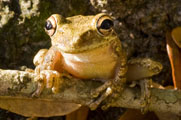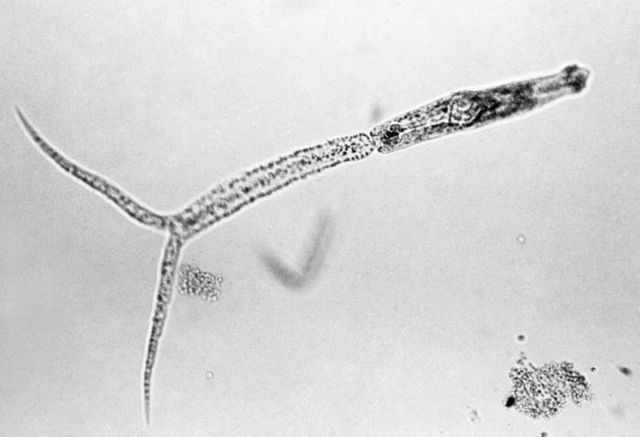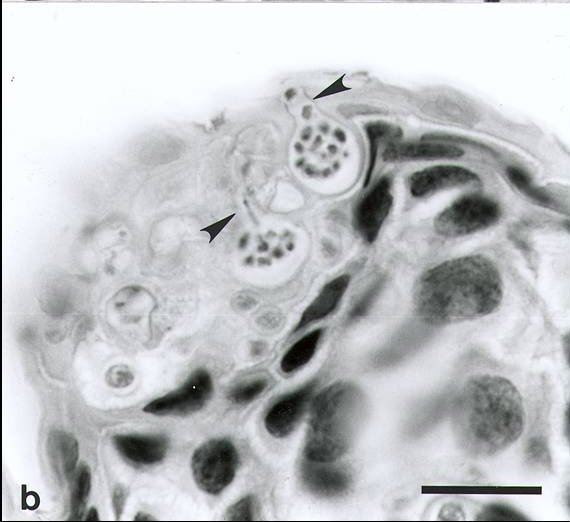

Rohr Laboratory of Ecology and Public Health
| Amphibian declines |
||
Chytridiomycosis. Ventral skin of upper hind limb of Atelopus varius from western Panama. Two sporangia (spore-containing bodies of Batrachochytrium sp.) containing numerous zoospores are visible within cells of the stratum corneum. Each flask-shaped sporangium has a single characteristic discharge tube (arrow) at the skin surface. Exiting zoospores are visible in the discharge tubes of both sporangia. (source: Daszak P, Berger L, Cunningham A, Hyatt A, Green D, Speare R. Emerging Infectious Diseases and Amphibian Population Declines. Emerg Infect Dis. 1999 Nov-Dec.)
|
Research and Publications |
|
Amphibians are the most threatened vertebrate taxon on the planet. Nearly one-third of all amphibians are threatened with extinction. There are many contributing factors to amphibian declines including habitat loss, disease (e.g. amphibian chytrid fungus, trematode, and ranaviral infections), climate change, and pollution. We are attempting to understand and curb factors contributing to amphibian declines, as well as elucidate the importance of amphibians to ecosystems. In fact, the Rohr lab is actively researching the feasibility of developing a vaccination to curb chytrid fungal-related amphibian declines. Sample Publications Buck, J.C., Rohr, J.R., Blaustein, A.R. in press. Effects of nutrient supplementation on host-pathogen dynamics of the amphibian chytrid fungus: a community approach. Freshwater Biology McMahon, T.A., Rohr, J.R. 2015. Transition of chytrid fungus infection from mouthparts to hind limbs during amphibian metamorphosis. EcoHealth 12:188-193 Raffel, T.R., Halstead, N.T., McMahon, T.A., Davis, A.K., Rohr, J.R. 2015. Temperature variability and moisture synergistically interact to exacerbate an epizootic disease. Proceedings of the Royal Society of London B 282:20142039 McMahon, T.A., Sears, B.F., Venesky, M.D., Brown, J.M., Deutsch, K., Halstead, N.T., Lentz, G., Tenouri, N., Young, S., Civitello, D.J., Ortega, N., Fites, J.S., Reinert, L.K., Rollins-Smith, L.A., Raffel, T.R., Rohr, J.R. 2014. Amphibians acquire resistance to live and dead fungus overcoming fungal immunosuppression. Nature 511:224-227 (cover photo and featured cover story; Altmetric score of 262, 99th percentile) McMahon, T.A., Rohr, J.R. 2014. Trypan blue dye is an effective and inexpensive way to determine the viability of Batrachochytrium dendrobatidis zoospores. EcoHealth 11:164-167 Venesky, M.D., Liu, X., Sauer, E., Rohr, J.R. 2014. Linking manipulative experiments to field data to test the dilution effect. Journal of Animal Ecology 83:557-565 Venesky, M.D., Raffel, T.R, McMahon, T.A., Rohr, J.R. 2014. Confronting inconsistencies in the amphibian-chytridiomycosis system: implications for disease management. Biological Reviews 89:477-483 Rohr, J.R., Raffel, T.R., Halstead, N.T., McMahon, T.A., Johnson, S.A., Boughton, R.K., Martin, L.B. 2013. Early-life exposure to an herbicide has enduring effects on pathogen-induced mortality. Proceedings of the Royal Society of London B 280:20131502 (Altmetric score of 71) McMahon, T.A., Romansic, J.M., Rohr, J.R. 2013. Non-monotonic and monotonic effects of pesticides on the pathogenic fungus Batrachochytrium dendrobatidis in culture and on tadpoles. Environmental Science and Technology 47:7958-7964 Rohr, J.R., Palmer, B.D. 2013. Climate change, multiple stressors, and the decline of ectotherms. Conservation Biology 27:741-751 Li, Y., Cohen, J.M., Rohr, J.R. 2013. A review and synthesis of the effects of climate change on amphibians. Integrative Zoology 8:145-161 Ranked as one of the four best papers published in the journal in 2013 https://mail.google.com/mail/u/0/?pli=1#inbox/1448714d25f3d5bf Liu, X., Rohr, J.R., Li, Y. 2013. Climate, vegetation, introduced hosts and trade shape a global wildlife pandemic. Proceedings of the Royal Society of London B 280: 20122506double star recommendation by Faculty 1000 McMahon, T.A., Brannelly, L.A., Chatfield, M.W.H., Johnson, P.T.J., Joseph, M.B., McKenzie, V.J., Richards-Zawacki, C.L., Venesky, M.D., Rohr, J.R. 2013. Chytrid fungus Batrachochytrium dendrobatidis has nonamphibian hosts and releases chemicals that cause pathology in the absence of infection. Proceedings of the National Academy of Sciences of the United States of America 110: 210-215 (Altmetric score of 57, 98th percentile) Venesky, M.D., Mendelson, J.R., Sears, B.F., Stiling, P.D., Rohr, J.R. 2012. Selecting for tolerance against pathogens and herbivores to enhance the success of reintroduction and translocation programs. Conservation Biology 26: 586-592 McMahon, T.A., Halstead, N.T., Johnson, S., Raffel, T.R., Romansic, J.M., Crumrine, P.W., Boughton, R.K., Martin, L.B., Rohr, J.R. 2011. The fungicide chlorothalonil is nonlinearly associated with corticosterone levels, immunity, and mortality in amphibians. Environmental Health Perspectives 119: 1098-1103 Romansic, J.M., Johnson, P.T.J., Searle, C.L., Johnson, J.E., Tunstall, T., Han, B.A., Rohr, J.R., Blaustein, A.R. 2011. Individual and combined effects of multiple pathogens on Pacific treefrogs. Oecologia 166: 1029-1041 Schotthoefer, A.M., Rohr, J.R., Cole, R.A., Koehler, A.V., Johnson, C.M., Johnson, L.B., Beasley, V.R. 2011. Effects of wetland and landscape variables on parasite communities of Rana pipiens: links to anthropogenic changes. Ecological Applications 21: 1257-1271 Rohr, J.R., Halstead, N.T., Raffel, T.R. 2011. Modelling the future distribution of the amphibian chytrid fungus: The influence of climate and human-associated factors. Journal of Applied Ecology 48: 174-176 (invited submission) Raffel, T.R., Michel, P.J., Sites, E.W., Rohr, J.R. 2010. Does temperature drive chytrid infections in newt populations? Associations with leaf litter, vegetation and shade. EcoHealth 7: 526-536 Rohr, J.R., Raffel, T.R. 2010. Linking global climate and temperature variability to widespread amphibian declines putatively caused by disease. Proceedings of the National Academy of Sciences of the United States of America 107: 8269-8274 Rohr, J.R., McCoy, K.A. 2010. A qualitative meta-analysis reveals consistent effects of atrazine on freshwater fish and amphibians. Environmental Health Perspectives 118: 20-32 Rohr, J.R., Raffel, T.R., Sessions, S.K. 2009. Digenetic trematodes and their relationship to amphibian declines and deformities. In: Amphibian Biology. vol. 8. Amphibian Decline: Diseases, Parasites, Maladies, and Pollution. series editor Heatwole, H. & Wilkinson, J.W. Surrey Beatty & Sons, Chipping Norton, NSW, Australia, pp 3067-3088 Rohr, J.R., Raffel, T.R., Romansic, J., McCallum, H., Hudson, P.J. 2008. Evaluating the links between climate, disease spread, and amphibian declines. Proceedings of the National Academy of Sciences of the United States of America.105: 17436-17441 Rohr, J.R., Schotthoefer, A.M., Raffel, T.R., Carrick, H.J., Halstead, N., Hoverman, J.T., Johnson, C.M., Johnson, L.B., Lieske, C., Piwoni, M.D., Schoff, P.K., Beasley, V.R. 2008. Agrochemicals increase trematode infections in a declining amphibian species. Nature 455: 1235-1239 Featured on the cover Rohr, J.R., Raffel, T.R., Sessions, S.K., Hudson, P.J. 2008. Understanding the net effects of pesticides on amphibian trematode infections. Ecological Applications 18: 1743-1753 Raffel, T.R., Rohr, J.R., Kiesecker, J.M., Hudson, P.J. 2006. Negative effects of changing temperature on amphibian immunity under field conditions. Functional Ecology 20: 819-828 Rohr, J.R., Sager, T., Sesterhenn, T., Palmer, B.D. 2006. Exposure, post-exposure, and density-mediated effects of atrazine on amphibians: Breaking down net effects into their parts. Environmental Health Perspectives 114: 46-50 Featured on the cover Rohr, J.R., Palmer, B.D. 2005. Aquatic herbicide exposure increases salamander desiccation risk eight months later in a terrestrial environment. Environmental Toxicology and Chemistry 24: 1253-1258 Rohr, J.R., Elskus, A.A., Shepherd, B.S., Crowley, P.H., McCarthy, T.M., Niedzwiecki, J.H., Sager, T., Sih, A., Palmer, B.D. 2004. Multiple stressors and salamanders: Effects of an herbicide, food limitation, and hydroperiod. Ecological Applications 14: 1028-1040 Rohr, J.R., Elskus, A.A., Shepherd, B.S., Crowley, P.H., McCarthy, T.M., Niedzwiecki, J.H., Sager, T., Sih, A., Palmer, B.D. 2003. The lethal and sublethal effects of atrazine, carbaryl, endosulfan, and octylphenol on the streamside salamander, Ambystoma barbouri. Environmental Toxicology and Chemistry 22: 2385-2392 Rohr, J.R., Madison, D.M. 2003. Dryness increases predation risk in efts: Support for an amphibian decline hypothesis. Oecologia 135: 657-664 For a full list of publications, please see the Publications page on this website. |
||
